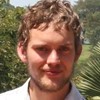Ground & Space Sensors for Monitoring Resilience of Forest Canopy Structure & Forest Functioning (1)
.
Session Chair
Kim Calders
,
Ghent University
Marion Pfeifer
,
Newcastle University
| Wednesday, May 15, 2019 |
| 08:30 - 10:10 |
| Brown 1 - Floor 2 |
Speaker
08:30 - 08:45
Oral Presentation
New 3D measurements and models of canopy structure, and the insights this can provide
Mathias Disney, UCL Geography, WC1E 6BT, United Kingdom; NERC National Centre for Earth Observation, UK
1UCL Geography, WC1E 6BT, United Kingdom, 2NERC National Centre for Earth Observation, UK
08:45 - 09:00

Oral Presentation
From Field To Maps: How To Use Canopy Structure Data Within the Framework Of The Essential Biodiversity Variables
Marion Pfeifer, MEP RG, Newcastle University, Newcastle Upon Tyne, United Kingdom
The Global LAI Project, Philip J Platts2
1MEP RG, Newcastle University, Newcastle Upon Tyne, United Kingdom, 2University of York, York, United Kingdom
1MEP RG, Newcastle University, Newcastle Upon Tyne, United Kingdom, 2University of York, York, United Kingdom
09:00 - 09:15

Oral Presentation
Fusion of Terrestrial and UAV LIDAR for Monitoring Forest Structure
Kim Calders, Computational & Applied Vegetation Ecology, Ghent University, Belgium
Harm Bartholomeus2, Martin Herold2, Barbara D'hont1, Louise Terryn1, Hans Verbeeck1
1Computational & Applied Vegetation Ecology, Ghent University, Belgium, 2Laboratory of Geo-Information Science and Remote Sensing, Wageningen University & Research, The Netherlands
1Computational & Applied Vegetation Ecology, Ghent University, Belgium, 2Laboratory of Geo-Information Science and Remote Sensing, Wageningen University & Research, The Netherlands
09:15 - 09:30

Oral Presentation
Tropical Tree Biomass Equations from Terrestrial LiDAR
Alvaro Lau, Laboratory of Geo-Information Science and Remote Sensing, Wageningen University & Research, Wageningen, Netherlands; Center for International Forestry Research (CIFOR), Bogor, Indonesia
Kim Calders3, Harm Bartholomeus1, Christopher Martius2, Pasi Raumonen4, Martin Herold1, Matheus Vicari5, Hansrajie Sukhdeo6, Jeremy Singh6, Rosa C. Goodman7
1Laboratory of Geo-Information Science and Remote Sensing, Wageningen University & Research, Wageningen, Netherlands, 2Center for International Forestry Research (CIFOR), Bogor, Indonesia, 3cCAVElab - Computational & Applied Vegetation Ecology, Ghent University, Ghent, Belgium, 4Laboratory of Mathematics, Tampere University of Technology, Tampere, Finland, 5Department of Geography, University College London (UCL), London, United Kingdom, 6Guyana Forestry Commission (GFC), Georgetown, Guyana, 7Department of Forest Ecology and Management, Swedish University of Agricultural Sciences (SLU), Umeå, Sweden
1Laboratory of Geo-Information Science and Remote Sensing, Wageningen University & Research, Wageningen, Netherlands, 2Center for International Forestry Research (CIFOR), Bogor, Indonesia, 3cCAVElab - Computational & Applied Vegetation Ecology, Ghent University, Ghent, Belgium, 4Laboratory of Mathematics, Tampere University of Technology, Tampere, Finland, 5Department of Geography, University College London (UCL), London, United Kingdom, 6Guyana Forestry Commission (GFC), Georgetown, Guyana, 7Department of Forest Ecology and Management, Swedish University of Agricultural Sciences (SLU), Umeå, Sweden
09:30 - 09:45

Oral Presentation
Using LiDAR, TLS and Forest Inventory Data in Logging Concessions to Inform Forest Change Mapping Using Sentinel-1 and Sentinel-2 Time Series
Edward Mitchard, University Of Edinburgh, Edinburgh, United Kingdom
Iain McNicol1, Chiara Aquino1, Mathew Disney2, Andrew Burt2
1University Of Edinburgh, Edinburgh, United Kingdom, 2University College London, London, UK
1University Of Edinburgh, Edinburgh, United Kingdom, 2University College London, London, UK
09:45 - 10:00
Oral Presentation
Remote sensing to track a bipolar response of forests and grasses to variations in soil water content
Sophia Walther, Max-Planck-Institute for Biogeochemistry, Jena, Germany; European Commission, Joint Research Centre, Directorate D Sustainable Resources - Bio-Economy Unit, Ispra, Italy; GFZ German Research Centre for Geosciences, Helmholtz-Centre Potsdam, Section 1.4 Remote Sensing, Potsdam, Germany
Gregory Duveiller2, Martin Jung1, Luis Guanter3,5, Alessandro Cescatti2, Gustau Camps-Valls4
1Max-Planck-Institute for Biogeochemistry, Jena, Germany, 2European Commission, Joint Research Centre, Directorate D Sustainable Resources - Bio-Economy Unit, Ispra, Italy, 3GFZ German Research Centre for Geosciences, Helmholtz-Centre Potsdam, Section 1.4 Remote Sensing, Potsdam, Germany, 4Universitat de València, Image Processing Laboratory (IPL), Valencia, Spain, 5Institute of Earth and Environmental Science, Potsdam University, Potsdam, Germany
1Max-Planck-Institute for Biogeochemistry, Jena, Germany, 2European Commission, Joint Research Centre, Directorate D Sustainable Resources - Bio-Economy Unit, Ispra, Italy, 3GFZ German Research Centre for Geosciences, Helmholtz-Centre Potsdam, Section 1.4 Remote Sensing, Potsdam, Germany, 4Universitat de València, Image Processing Laboratory (IPL), Valencia, Spain, 5Institute of Earth and Environmental Science, Potsdam University, Potsdam, Germany
